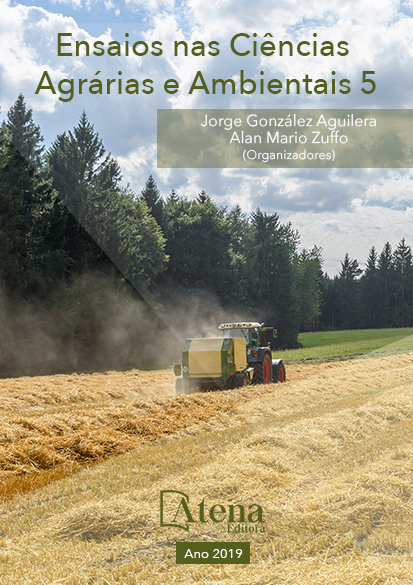
EVAPOTRANSPIRAÇÃO REAL POR TÉCNICAS DE SENSORIAMENTO REMOTO ORBITAL NA REGIÃO SEMIÁRIDA DO NORDESTE BRASILEIRO
O monitoramento ambiental por meio
das técnicas de sensoriamento remoto é cada
vez mais aplicável nas regiões semiáridas do
Nordeste brasileiro, à exemplo da determinação
do processo da evapotranspiração que permite
observar sua distribuição especializada
sobre os diferentes usos do solo. Neste
contexto, objetivou-se identificar o processo
da evapotranspiração real sobre os diferentes
usos do solo em região semiárida através da
sua espacialização por sensoriamento remoto
orbital com uso de imagens Landsat. A área
de estudo é o município de Iguatu, localizado
no estado do Ceará, região semiárida do
Nordeste do Brasil. Para desenvolvimento do
estudo duas imagens orbitais de satélite foram
processadas através do algoritmo SEBAL, por
meio da utilização de dados meteorológicos
de superfície. Os resultados foram analisados
e submetidos a medidas de tendência central
(mínimo, máximo e médio) e dispersão (desvio
padrão, variância e coeficiente de variação).
Com a espacialização da evapotranspiração
foi observado que a menor evapotranspiração
real diária esteve sobre solos com pouca ou
nenhuma vegetação, destacando as áreas de
solo exposto. Em contraste, as áreas irrigadas e
na vegetação de caatinga densa apresentaram
a maior evapotranspiração. O sensoriamento
remoto identificou espacialmente a variabilidade
quantitativa e qualitativa da evapotranspiração
real diária, sendo essencial para o
monitoramento ambiental, de forma prática e
eficiente no planejamento e organização na
tomada de decisões dos recursos hídricos e naturais do semiárido brasileiro.
EVAPOTRANSPIRAÇÃO REAL POR TÉCNICAS DE SENSORIAMENTO REMOTO ORBITAL NA REGIÃO SEMIÁRIDA DO NORDESTE BRASILEIRO
-
DOI: 10.22533/at.ed.41419160110
-
Palavras-chave: Caatinga; Uso e ocupação do solo; Mudanças climáticas; Escassez de água; Imagens orbitais.
-
Keywords: Caatinga; Use and occupation of soil; Climate changes; Water shortage; Orbital images.
-
Abstract:
The Environmental monitoring through remote sensing techniques is
increasingly applicable in the semiarid regions of the Brazilian Northeast, for example
on determination of the process of evapotranspiration that allows to observe its
specialized distribution on the different uses of the soil. In this context, the objective
was to identify the actual evapotranspiration process on the different soil uses in the
semiarid region through its orbital remote sensing spatialization using Landsat images.
The area of study was the municipality of Iguatu, located in the state of Ceará, semiarid
region of Northeast Brazil. For the development of the study two orbital satellite images
were processed through the SEBAL algorithm, using surface meteorological data.
The results were analyzed and submitted to measures of central tendency (minimum,
maximum and average) and dispersion (standard deviation, variance and coefficient
of variation). With the evapotranspiration spatialization, it was observed that the lowest
actual evapotranspiration daily was on soils with little or no vegetation, highlighting
the areas of epoch soil. In contrast, irrigated areas and dense caatinga vegetation
presented the highest evapotranspiration. Remote sensing identified spatially the
quantitative and qualitative variability of actual evapotranspiration daily, being essential
for the environmental monitoring, in a practical and efficient way in the planning and
organization in the decision making of the water and natural resources of the Brazilian
semiarid.
-
Número de páginas: 15
- Jhon Lennon Bezerra da Silva


